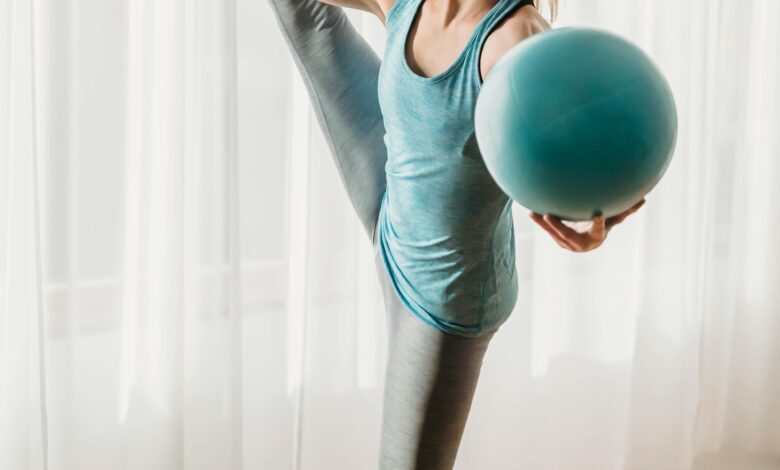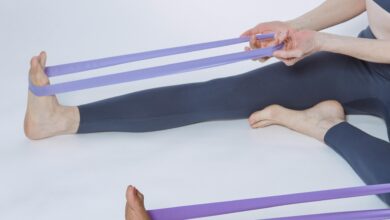How to Use a Stability Ball for Core Workouts

A stability ball, also known as an exercise ball or Swiss ball, is a versatile and effective tool for strengthening your core muscles. Unlike traditional exercises performed on a stable surface, using a stability ball introduces an element of instability, forcing your core muscles to engage more actively to maintain balance. This not only enhances core strength but also improves posture, balance, and overall functional fitness.
In this article, we’ll explore how to use a stability ball effectively for core workouts, including proper techniques, safety tips, and a variety of exercises to target different areas of your core.
Why Use a Stability Ball for Core Workouts?
Before diving into the exercises, it’s important to understand why a stability ball is such a valuable tool for core training:
- Engages Stabilizer Muscles : The instability of the ball forces smaller stabilizer muscles in your core to work harder, leading to improved balance and coordination.
- Improves Posture : Many stability ball exercises require you to maintain proper alignment, which strengthens the muscles responsible for good posture.
- Increases Range of Motion : The ball allows for greater movement during exercises, which can enhance flexibility and muscle activation.
- Versatility : A stability ball can be used for a wide range of exercises targeting not just the core, but also the arms, legs, and back.
- Low-Impact Option : Stability ball exercises are generally low-impact, making them suitable for people of all fitness levels, including beginners and those recovering from injury.
Choosing the Right Stability Ball
Before starting your workout, ensure you have the correct size stability ball for your height:
- 55 cm ball : For individuals 5’0” to 5’5”
- 65 cm ball : For individuals 5’6” to 6’0”
- 75 cm ball : For individuals taller than 6’0”
To check if the ball is the right size, sit on it with your feet flat on the floor. Your knees should be at a 90-degree angle, and your thighs should be parallel to the ground.
Safety Tips for Using a Stability Ball
While stability balls are safe when used correctly, improper use can lead to injury. Follow these safety tips:
- Check the Ball’s Condition : Ensure the ball is properly inflated and free of punctures or damage.
- Use on a Non-Slip Surface : Place the ball on a flat, non-slip surface to prevent it from rolling away.
- Start Slowly : If you’re new to stability ball exercises, begin with basic movements and gradually progress to more advanced exercises.
- Maintain Proper Form : Focus on engaging your core and maintaining good posture throughout each exercise.
- Avoid Overinflation : An overinflated ball is less stable and harder to control, increasing the risk of injury.
Top Stability Ball Exercises for Core Strength
Here are some of the best stability ball exercises to target your core muscles:
1. Stability Ball Plank
Targeted Muscles : Entire core (especially the transverse abdominis), shoulders, and glutes.
- How to Perform :
- Place your forearms on the stability ball and extend your legs behind you into a plank position.
- Keep your body in a straight line from head to heels, engaging your core to prevent your hips from sagging.
- Hold the position for 20-60 seconds, depending on your fitness level.
Tip : To make it easier, start with your knees on the ground.
2. Stability Ball Roll-Out
Targeted Muscles : Rectus abdominis, obliques, and lower back.
- How to Perform :
- Kneel on the floor with the stability ball in front of you.
- Place your forearms on the ball and slowly roll it forward, extending your body into a plank position.
- Roll the ball back toward your knees and return to the starting position.
- Perform 10-15 repetitions.
Tip : Keep your core engaged throughout the movement to avoid arching your back.
3. Stability Ball Russian Twists
Targeted Muscles : Obliques, rectus abdominis, and lower back.
- How to Perform :
- Sit on the stability ball and walk your feet forward until your upper back is supported by the ball.
- Lift your hips so your body forms a straight line from shoulders to knees.
- Hold a weight or medicine ball with both hands and twist your torso to one side, then the other.
- Perform 10-15 twists per side.
Tip : If you don’t have a weight, you can clasp your hands together instead.
4. Stability Ball Crunches
Targeted Muscles : Upper abs, rectus abdominis.
- How to Perform :
- Sit on the stability ball and walk your feet forward until your lower back is supported by the ball.
- Place your hands behind your head or across your chest.
- Engage your core and lift your shoulders off the ball, performing a crunch.
- Lower back down with control and repeat for 10-15 repetitions.
Tip : Avoid pulling on your neck; focus on using your core muscles to lift your upper body.
5. Stability Ball Pike
Targeted Muscles : Lower abs, hip flexors, and shoulders.
- How to Perform :
- Start in a plank position with your shins resting on the stability ball.
- Engage your core and lift your hips toward the ceiling, rolling the ball toward your hands.
- Pause at the top, then slowly return to the starting position.
- Perform 8-12 repetitions.
Tip : Keep your movements controlled to maximize core engagement.
6. Stability Ball Bridge
Targeted Muscles : Lower back, glutes, and hamstrings.
- How to Perform :
- Lie on your back with your feet resting on the stability ball and arms at your sides.
- Lift your hips toward the ceiling, squeezing your glutes and engaging your core.
- Hold for a few seconds, then lower back down.
- Perform 10-15 repetitions.
Tip : For an added challenge, lift one leg off the ball while holding the bridge position.
7. Stability Ball Side Plank
Targeted Muscles : Obliques, shoulders, and glutes.
- How to Perform :
- Lie on your side with your forearm on the stability ball and your legs extended.
- Lift your hips off the ground, forming a straight line from head to feet.
- Hold the position for 20-60 seconds, then switch sides.
Tip : If this is too challenging, bend your bottom knee for support.
Sample Stability Ball Core Workout Routine
Here’s a sample workout routine that incorporates several of the exercises listed above:
- Stability Ball Plank : 3 sets of 20-60 seconds
- Stability Ball Roll-Out : 3 sets of 10-15 reps
- Stability Ball Russian Twists : 3 sets of 10-15 twists per side
- Stability Ball Crunches : 3 sets of 10-15 reps
- Stability Ball Pike : 3 sets of 8-12 reps
- Stability Ball Bridge : 3 sets of 10-15 reps
Perform this routine 2-3 times per week for optimal results.
Additional Tips for Maximizing Your Stability Ball Workouts
- Focus on Breathing : Exhale during the exertion phase of each exercise (e.g., when lifting your body) and inhale during the relaxation phase.
- Progress Gradually : As you become stronger, increase the difficulty by adding weights, performing more repetitions, or trying advanced variations.
- Combine with Other Exercises : Use the stability ball as part of a full-body workout by incorporating exercises for your arms, legs, and back.
- Stay Consistent : Like any fitness program, consistency is key to seeing results. Aim to incorporate stability ball exercises into your routine regularly.




